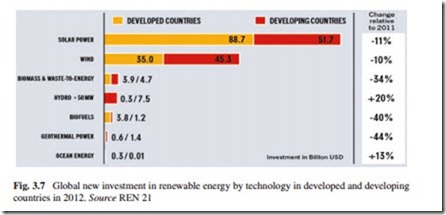Investment in Hydropower Plants
Investment in large hydropower projects of more than 50 MW continued to be significant in 2012, exceeding all other renewable energy sectors, except wind and solar power (Fig. 3.7). Translating capacity additions into asset finance dollars per year is not straightforward because the average project takes four years to build, but it is estimated that asset financing for large hydropower projects commissioned in 2012 totaled at least US$33 billion—over a fifth of the US$148.5 billion value of asset finance excluding large hydro.
It is foreseeable that Europe needs to invest around US$6.8 trillion in new power plants and in infrastructure in order to satisfy the expected increase in the demand of electricity during the period 2011–2020, a total of US$10.1 trillion for
the period 2021–203510 for the same purpose, and a total of US$136 billion in new hydropower capacities during the period 2011–2035 (WEO 2011).
On the other hand, it is important to highlight that the best sites for producing renewables-based electricity are not always located close to the centers of demand. To exploit remote renewable energy sources, additional high-voltage transmission lines have to be built and some aspects of existing transmission and distribution networks reinforced. The associated capital costs are known as grid integration costs and make up one part of the total system integration costs. These costs are as follows:
• Adequacy costs: Electricity systems must have enough generating capacity available to meet system demand even at peak times. Variable renewables make a relatively low contribution to system adequacy, because only a small proportion of their potential output is certain to be available at times of peak demand. As a result, other plants are needed in the system to compensate for this variability. Based on expert’s estimates, the costs associated with this additional capacity range from US$3 per MWh to US$5 per MWh of variable renewables generation;
• Balancing costs: The variable nature of supply requires more flexibility from the rest of the power system, typically on short timescales. Additional services are needed in order to perfectly match supply and demand and to maintain sys- tem stability. Balancing services can be supplied by flexible generation, smart grids, strong interconnections between grids, or energy storage technologies, such as pumped hydropower plants, compressed air, and large-scale batteries. The costs are largely operational (rather than capital) and range between US$1 per MWh and US$7 per MWh of variable generation, depending on the region;
• Grid integration costs: Once renewables capacity is built, it must be linked to the existing power grid and existing transmission and distribution networks may need to be reinforced to transport the generated electricity to consumers. The costs range from US$2 per MWh to US$13 per MWh for variable renewables.
According to experts’ calculations, over the period 2011–2035, grid integration costs of renewables make up 10 % of total transmission investment costs world- wide (excluding investment in distribution), 14 % of transmission investment in the OECD, and 25 % of transmission investment in the EU. The share in global transmission and distribution investment costs taken together is 3 %.
Due to political and economic reasons, the prediction of the future development of Europe’s hydropower park is a difficult task. Public opposition to large hydro schemes will probably result in very little new development of big dams and res- ervoirs. Small-scale and low-head hydropower capacity will probably increase in the future as research on low-head turbines, and standardized turbine production, lowers the costs of hydroelectric power at sites with low heads. A new computer- ized control systems and improved turbines may allow more electricity to be gen- erated from existing facilities in the future. As well, many small hydroelectric sites were abandoned in the 1950s and 1960s when the price of oil and coal was very low, and their environmental impacts unrealized. Increased fuel prices in the future could result in these facilities being refurbished.
In addition, it is important to highlight that there is a clear agreement or under- standing within the EU that a dismantling of the existing hydroelectric power plants is not an advisable option; they should continue to operate, and perhaps their number and capacities will be increased in the future.
Renovation, modernization, and upgrading of old hydropower plants is often less costly than developing a new power plant, often has relatively smaller envi- ronment and social impacts, and requires less time for implementation. Capacity additions through renovation, modernization, and upgrading of old hydropower plants can therefore be attractive. Selective replacement or repair of identifying hydropower plant components such as turbine runners, generator windings, excita- tion systems, governors, control panels, or trash cleaning devices can reduce costs and save time. It can also lead to increased efficiency, peak power, and energy availability of the plant (Prabhakar and Pathariya 2007).
